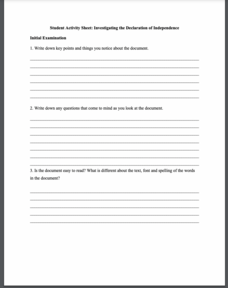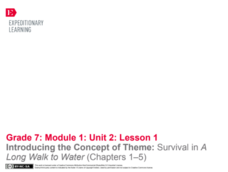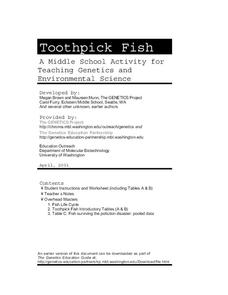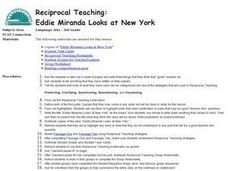Montana State University
Climb into Action!
Climate change affects even the largest and intimidating of landforms—even Mount Everest! A resource helps teach learners the connection between global climate change and its effects on Earth. Activities include videos, class discussion,...
5280 Math
Stories That Formulas Tell
Learn the stories a formula holds. An interesting lesson takes a unique approach to teach how to use formulas. Beginning with a formula, learners predict what the variables stand for and then use the formula to make calculations and tell...
Annenberg Foundation
Teaching Geography: Workshop 4—North Africa/Southwest Asia
Can Jerusalem be equitably organized? Can Israel and Palestine be successfully partitioned? Part one of a two-part workshop looks at the geo-political history of Jerusalem while Part two investigates Egypt's dependence of the Nile River...
Lafayette Parrish School System
Teaching Tone and Mood
Tone and Mood are not synonymous! Introduce young readers to these literary devices with a series of exercises that not only point out the significant differences between the terms but also shows them how to identify both the tone and...
Learning A-Z
Tips for Teaching: Word Recognition
Learning to read can be exhilarating for some pupils, but for others, it's difficult to get past the frustration of not knowing how to read a particular word. A tutoring resource provides several ways to guide class members into...
College Board
AP® English Language: Reading and Writing Analytically
How can teachers ensure their pupils are well prepared for the AP® English exam? The reference material is a good place to start! Educators read seven essays detailing best practices for teaching scholars to read critically and write...
Roy Rosenzweig Center for History and New Media
Investigating the Declaration of Independence
Teach your class about the Declaration of Independence while giving them practice working as a team. The resource breaks participants into groups and has them answer questions about specific grievances from the Declaration of...
PBS
Analyzing McCulloch v. Maryland
What happened in the Supreme Court case of McCulloch v. Maryland? The resource teaches the specifics of the case with a video and provided discussion questions covering issues such as precedent and the Supreme Court as an equal branch of...
PBS
How to Teach Your Students about Fake News
What media literacy skills do people need to evaluate a news source? Scholars listen to and discuss an NPR story about how fake headlines often dupe young people and adults alike. Next, they study news stories, using a fact-checking...
EngageNY
Building Background Knowledge: The Lost Boys of Sudan
Get deep! Teach scholars how to make connections between texts to deepen their understanding of a topic. Using the resource, pupils read and annotate a short informational text about Sudan's Civil War and refugee crisis. Next, they...
EngageNY
Introducing the Concept of Theme: Survival in A Long Walk to Water (Chapters 1–5)
Teach the class how to survive! Scholars work together to learn the meaning of theme and determine the message in A Long Walk to Water. After the class discusses possible ideas, they work to identify one central theme for the text....
Education Bureau of Hong Kong
Evaluating Casual Claims
Responsible decision making relies on the ability to a recognize, analyze, and evaluate claims. The worksheets and activities in this 32-page packet teach learners how to distinguish among opinions, reasoned arguments, facts, and logical...
American Chemical Society
Designing an Absorbency Test
Time to soak up some learning! A hands-on lesson teaches learners about the absorbency properties of substances. They conduct tests by dipping different materials in water to determine which hold water and then complete a handout to...
News Literacy Project
News Goggles: Identifying the News Source
A 25-slide presentation teaches viewers how to identify the source of stories in newspapers and online news sites. The slides show how to locate the byline where either the reporter's name or the wire service that provided the story can...
Curated OER
Teaching Poetic Devices
Students identify and analyze the poetic devices of alliteration, metaphors, onomatopoeia, personification, rhyme, and similes. They identify examples of each poetic device in songs, complete a worksheet, and teach the devices to a...
Curated OER
Wants and Needs
Here is an outstanding lesson on wants versus needs designed for 1st graders. Pupils listen to the book, Something Good which presents themes on wants, needs, choice, resources, and counting money. Pupils complete worksheets embedded in...
Community Resources for Science
"5 E's" Science Planning Worksheet
This two-page planning guide walks you through a five-part process for teaching scientific content. To begin, decide how you will evaluate learners' progress, then what tools you will use to engage them in the topic. Plan how they will...
ESL Kid Stuff
Past Tense Activities - Regular Verbs
Here is a supplemental lesson plan regarding past tense verbs for English language learners that is a great tool for the classroom when you are teaching grammar exercises.
University of Washington
Toothpick Fish
With colored toothpicks representing genes, youngsters practice passing them through generations of fish and learn about heredity. Consider this as an introductory activity since it does not represent recessive genes with lowercase...
Curated OER
Looking at Teachers Among Us: A Workshop in Conceptions of Teaching
Students characterize various traditional conceptions of teaching and apply these to authentic teaching situations. Teaching art, math and grading systems are analyzed in this lesson.
Curated OER
Teach Science
The students will be learning a Science concept, through a hands-on investigation, well enough to teach it and also understanding
PowerPoint¿¿ in order to create their presentation. Through this presentation a group of students will be...
Curated OER
Incorporating Literature into Social Studies Teaching and Learning
Students engage in a study of incorporating literature into the Social Studies classroom. They review a variety of literature sources and then create a bulletin board with the information. Then students practice using the Reader's...
Curated OER
Students Teaching Equations of a Line
Students are divided into groups and then each group is assigned a separate topic related to the equation of a line. Each group researches their topic and then they teach the rest of the groups about it.
Curated OER
Reciprocal Teaching: Eddie Miranda Looks at New York
Third graders use the strategies in Reciprocal Teaching: predicting, clarifying, questioning, summarizing, and visualizing. They utilize these reading strategies when reading "Eddie Miranda Looks at New York."
Other popular searches
- Teacher Resources
- Substitute Teaching
- Teaching Phonics
- Teacher Websites
- Teachers
- Teaching Main Idea
- Substitute Teacher Resources
- Teachers in Space
- Teaching Inference
- Teachers Sites
- Science Teacher Resources
- Teaching Volleyball








